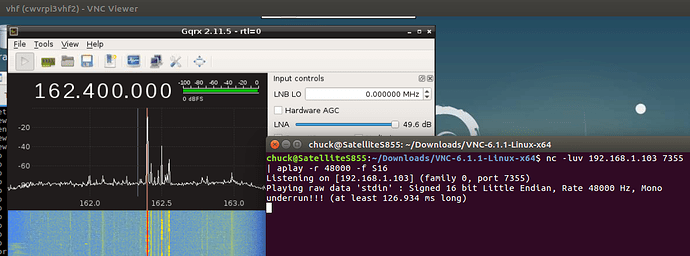What gain settings are people using for their rtlsdr. I can’t seem to get the waterfall out of the blue. I know my antenna/LNA work better than what I’m getting now.
Hi,
You can get this information from existing observations. In an observation page, you expand the Metadata items, then the radio item. You find someone who has the same type of device as yours (from rx_device info), then you will have the gain from the rf_gain field (or other gain fields).
Otherwise it depends a lot on the antena, if you already have a preamplifier and on the type of device.
You may want to start with easy satellites (with strong satellite emission and easy to identify). I would say LUSAT in UHF and a Funcube, XW or NOAA in VFH. Check existant data to select a proper satellite and emitter.
73,
Thanks Francois
That was easy. I never thought of looking in there. Unfortunately that didn’t help as there are no 2 users with the same configuration so I will experiment. I’ll start with bb & if gain at 00 and rf gain at 30 and see how high I can go before experiencing problems. Also I noticed my results are not that far behind when compared against some of the others.
73 Bob vk2byf
I would start with the highest gain and reduce to get proper results. Starting too low and you might need several tries to get a signal. With high gain, you can tell if the rest of the system is working, ie: antenna, feedline, etc.
Hi,
30dB is not a valid gain value. Refer to https://wiki.satnogs.org/SatNOGS_Client_Ansible for the vaild gain steps you can use.
In my experience, without LNA I left IF and BB gain as default and put RF gain at 49.6 for the best results.
Now I added a SPF5189 LNA and I decreased the gain at 29.7, but I’m still tuning it for best results.
73 Alfredo IZ7BOJ
Hi Alfredo
I read somewhere that if you set the RF gain to, say 30, it will select the setting nearest to that number. This has worked for me with Gqrx and SDR# for a number of years. I have an LNA4ALL at the antenna so I will try RF gain 29.7 and BB/IF gain at default. Adding an SPF5189 and the other end of he coax just gave me more noise and made the local spurii worse.
Thanks for your input.
I’m still wondering why my signal received from the same antenna via a modified TV splitter is so much better on my SDRplay SDRuno combination. The obvious answer would be to blame the rtl-sdr but it works fine with Gqrx without SatNOGS.
Looking at other peoples observations, they look much like my own.
73, Bob
I have got my station working again with RF gain set at 8.7. I get good CW copy. No BB gain no IF gain.
I’m going to sneak it up little by little. Now it’s on 16.6
bob
Maybe a working procedure is to run real time gqrx with the target hardware and adjust the gain slider until the noise floor starts to rise with it? Or with a signal for best snr.
However last time I tried it with rtl_tcp I did not get expected results and reverted to trials also.
From what I remember the noise floor used to rise around 10db gain.
I have a masthead low noise LNA4ALL amplifier.
It’s working well at the moment on 10.5db RF gain. Default IF & BB gain.
As we say down under, if it’s not broken don’t fix it.
Will need this shortly as the NEXT 2m antenna will have an lna4all on the mast.
This shows the signals with local weather service, without a preamp, maybe 25 ft rg58, gain at max w/o too much noise. Went ahead and made a project of setting up vnc remote desktop on the satnogs rpi image to run gqrx and pipe the audio over udp.
I tried all sots of antennas for satellites and finally settled on the home made QFH antenna using 3mm copper wire. I also made them from coax and 1/4" copper tubing. I even made a couple for transmitting.
My experience shows the QFH out performs the Dipole,Turnstile, and Eggbeater antennas.
Regards masthead LNA. I tried home-brew, cheap and nasty ebay type and finally shelled out for the LNA4ALL. A word of caution. LNAs can become oscillators if not mounted correctly inside it’s metal enclosure. A cavity resonators of sorts. You’ll know when they take off when the current increases.
I bought a milled aluminium box from some guy in Canada, cost more than the LNA but it works even on L Band.
I love experimenting and building things.
have fun. 73 bob
Am inspired to make some QFH antenna after spotting one on the LEM in the Apollo 11 movie during seperation and other scenes 
